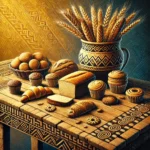1. Introduction to Kenyan Baking Traditions
1.1. Historical roots of baking in Kenya
The art of baking in Kenya has deep historical roots that predate colonial influence. Traditional Kenyan societies utilized local ingredients and methods to create a variety of baked goods, often using open fires or clay ovens. These early baking techniques laid the foundation for the diverse and flavorful baked products we see in Kenya today.
1.2. Influence of colonial and indigenous cultures
The arrival of colonial powers in Kenya brought new baking methods and ingredients, which blended with indigenous practices. This cultural fusion resulted in unique hybrid recipes that combined European baking techniques with local flavors and ingredients. For instance, the popular Kenyan tea bread is a testament to this culinary amalgamation.
1.3. Role of baking in Kenyan social gatherings
Baking plays a significant role in Kenyan social gatherings, serving as a means of bringing people together and celebrating important occasions. From weddings to funerals, and from religious festivals to community events, baked goods are often at the center of these gatherings, symbolizing hospitality and communal bonding.
2. Essential Ingredients in Kenyan Baking
2.1. Local grains and flours
Kenyan baking heavily relies on locally sourced grains and flours. Maize flour, known as ‘unga’ in Swahili, is a staple in many Kenyan baked goods. Other commonly used flours include wheat, millet, and sorghum, each imparting its unique flavor and nutritional profile to the final product.
2.2. Native fruits and nuts
Indigenous fruits and nuts add distinctive flavors and textures to Kenyan baked goods. Ingredients such as baobab fruit, tamarind, and macadamia nuts are often incorporated into various recipes, providing a truly authentic Kenyan taste experience.
2.3. Unique Kenyan spices and flavorings
Kenyan baking is characterized by its use of aromatic spices and flavorings. Cardamom, cinnamon, and cloves are frequently used to enhance the flavor profile of baked goods. Additionally, coconut milk and various local herbs contribute to the unique taste of Kenyan baked products.
3. Traditional Kenyan Breads
3.1. Chapati: The versatile flatbread
Chapati, a thin unleavened flatbread, is a staple in Kenyan cuisine. Its versatility allows it to be served with various dishes or enjoyed on its own. The process of making chapati involves skillfully rolling out the dough and cooking it on a hot griddle, resulting in a soft and pliable bread.
3.2. Mandazi: Kenya’s beloved doughnut
Mandazi, often referred to as the Kenyan doughnut, is a popular sweet treat. These triangular or rectangular-shaped pastries are deep-fried to achieve a golden-brown exterior while maintaining a soft interior. Mandazi can be flavored with cardamom or coconut, adding depth to their taste.
3.3. Mkate wa Sinia: The spongy rice bread
Mkate wa Sinia, also known as Swahili Rice Bread, is a unique bread made from rice flour and coconut milk. This bread is traditionally baked in a copper tray, giving it its distinctive shape and texture. The result is a spongy, slightly sweet bread that is often served during special occasions.
4. Kenyan Cakes and Pastries
4.1. Kaimati: Sweet dumplings with a twist
Kaimati are small, round dumplings made from wheat flour dough, deep-fried until golden brown, and then soaked in sugar syrup. These sweet treats are often flavored with cardamom and are a popular choice during festive seasons, particularly in coastal regions of Kenya.
4.2. Mahamri: The cardamom-spiced triangle treat
Mahamri, also known as Swahili Doughnuts, are triangular-shaped pastries flavored with cardamom and coconut milk. These deep-fried treats have a crispy exterior and a soft, slightly chewy interior. Mahamri are commonly enjoyed for breakfast or as a snack, often accompanied by tea.
4.3. Kenyan Christmas Cake: A festive delight
The Kenyan Christmas Cake is a rich, fruit-filled cake that has become a tradition during the holiday season. This cake incorporates a variety of dried fruits, nuts, and spices, often soaked in brandy or rum for added flavor. The cake is typically prepared well in advance of Christmas to allow the flavors to develop fully.
5. Modern Twists on Kenyan Baking
5.1. Fusion recipes blending Kenyan and international flavors
Contemporary Kenyan bakers are experimenting with fusion recipes that combine traditional Kenyan ingredients with international baking techniques. For example, a baobab and mango cheesecake or a macadamia nut croissant represents this innovative approach to Kenyan baking.
5.2. Healthy adaptations of traditional baked goods
There is a growing trend towards creating healthier versions of traditional Kenyan baked goods. This includes using whole grain flours, reducing sugar content, and incorporating more fruits and vegetables into recipes. For instance, a gluten-free version of chapati made with cassava flour is gaining popularity.
5.3. Kenyan-inspired desserts in fine dining
Kenyan flavors and ingredients are finding their way into high-end desserts in fine dining establishments. Chefs are reimagining traditional Kenyan sweets with modern plating techniques and unexpected flavor combinations, elevating Kenyan baking to new culinary heights.
6. Baking Techniques and Tips
6.1. Working with traditional Kenyan ovens
Traditional Kenyan ovens, such as the clay oven or ‘jiko’, require specific techniques to achieve optimal results. Understanding heat distribution and temperature control in these ovens is essential for successful baking. Many Kenyan bakers still prefer these traditional methods for their ability to impart unique flavors to baked goods.
6.2. Adapting recipes for modern kitchens
As modern kitchen appliances become more common in Kenyan households, there is a need to adapt traditional recipes accordingly. This involves adjusting cooking times, temperatures, and techniques to suit electric or gas ovens while maintaining the authentic taste and texture of the baked goods.
6.3. Preserving the authenticity of Kenyan flavors
Maintaining the authenticity of Kenyan flavors in baking requires careful selection and handling of ingredients. Using freshly ground spices, locally sourced produce, and traditional preparation methods are key to preserving the true essence of Kenyan baked goods.
7. The Cultural Significance of Kenyan Baking
7.1. Baking in Kenyan celebrations and rituals
Baked goods play a central role in many Kenyan celebrations and rituals. From wedding cakes to funeral breads, these baked items often carry symbolic meanings and are an integral part of cultural traditions. The act of preparing and sharing these baked goods strengthens community bonds and preserves cultural identity.
7.2. Passing down recipes through generations
The transmission of baking knowledge from one generation to the next is a cherished aspect of Kenyan culture. Family recipes are often closely guarded secrets, passed down orally or through handwritten notes. This practice ensures the continuity of traditional Kenyan baking techniques and flavors.
7.3. The role of baking in Kenyan hospitality
Baking is deeply intertwined with the concept of hospitality in Kenya. Offering freshly baked goods to guests is considered a sign of respect and welcome. This custom reinforces social ties and reflects the generous spirit of Kenyan culture.
8. Summary
Kenyan baking is a rich tapestry of flavors, techniques, and cultural significance. From traditional breads like chapati and mandazi to modern fusion desserts, the art of baking in Kenya continues to evolve while maintaining its roots in local ingredients and time-honored methods. As we explore the diverse world of Kenyan baked goods, we gain insight into the country’s history, cultural practices, and the warm hospitality that defines the Kenyan people.
9. FAQs
What are some common ingredients used in Kenyan baking?
How has colonial influence shaped Kenyan baking traditions?
What is the significance of mandazi in Kenyan culture?
How are traditional Kenyan baking techniques being adapted for modern kitchens?
What role does baking play in Kenyan social gatherings and celebrations?











